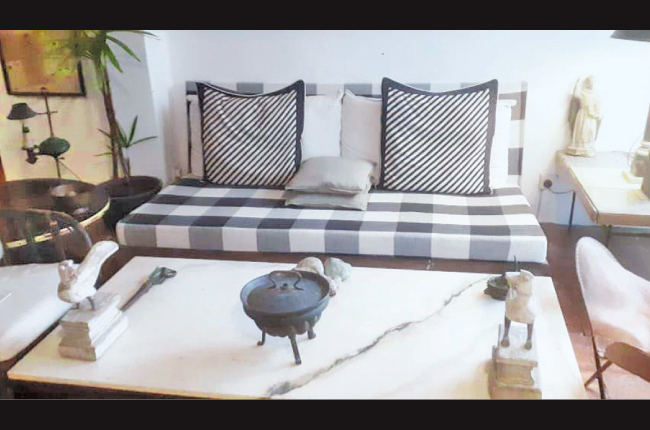As a result of managing all of Geoffrey Bawa’s properties, the Geoffrey Bawa Trust is very much at the forefront of the conservation of modern art and architecture. But what makes No. 11 so special? Why is it key to understanding the work of the Trust?
Throughout history there have always been those who have been drawn to certain places that have a certain mystique. These places may contain objects associated with those who are still remembered even after death. Also, places connected to those who have acquired a legendary reputation during their lifetime still draw many visitors. The King, Elvis Presley’s home Graceland draws huge crowds each year. The well- known Occultist Aleister Crowley’s famous night inside the Great Pyramid of Egypt is still spoken about. Crowley reported a strange event that night, that can only be described as supernatural!
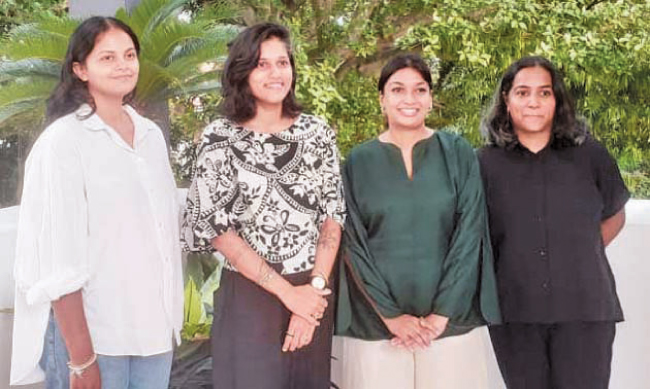
Aneesha Mustachi, Shanika Perera, Shayari De Silva and Thilini Perera
Pictures by Sudath Malaweera
No.11, 33rd Lane, Bagatelle Road, Colombo 03, is one of the most famous houses in Sri Lanka, because it is the house where the legend Geoffrey Bawa once called ‘home’. Though it is extremely unlikely that you will find anything supernatural here, what you will find are art and artifacts that have historical value. Bawa was a prodigious architect, because he had insight into the minds of men. He understood exactly what they wanted and he knew how to perform the task.
Why visit No. 11? Because even after his death, being at No. 11 allows you to partially experience the mind of the great architect Geoffrey Bawa. Inside the house, in a room, you will also see a fantastic hand hammered aluminum door that is a creation/design of the architect Ismeth Raheem who worked with Bawa in the 70s. Bawa did some work in Bali, and he picked up many pieces of art as he traveled, and you can see them all over the house.
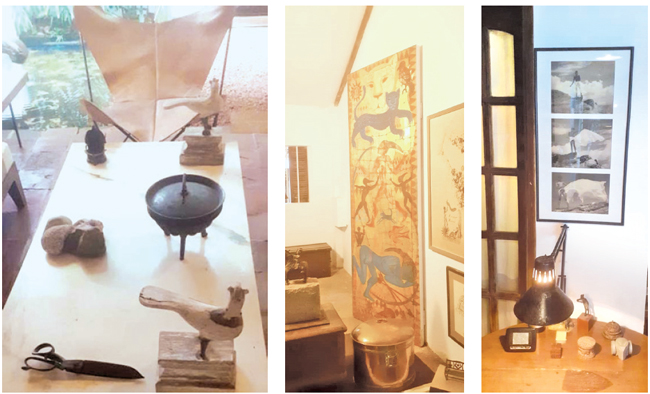
Inner feelings
There is something magical about houses. Maybe because they reveal a lot about the inner feelings or emotions of a person. Could they be windows to the soul? Here is what one needs to understand about No. 11. Just because Bawa transformed it into what it is today, it does not mean that it is the best house in the whole world. Bawa made it the way he made it, because Bawa wanted his own spaces. No one needed to teach Bawa how to build a house. Bawa was a master of his game.
We were taken on the house tour by Chief Curator Shayari De Silva, Senior Design and Communication Manager, Thilini 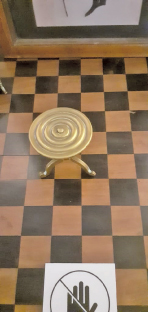 Perera, Aneesha Mustachi and Shanika Perera. They pointed out that Bawa experimented with light using skylights. Architects have always liked to experiment with light using skylights, and the house and Bawa are no exceptions. He also brought the environment in through courtyards. And on the tiny plot of land he created the illusion of endless space. Being the master illusionist, Geoffrey Bawa had one of the best architects in the world working for him – himself.
Perera, Aneesha Mustachi and Shanika Perera. They pointed out that Bawa experimented with light using skylights. Architects have always liked to experiment with light using skylights, and the house and Bawa are no exceptions. He also brought the environment in through courtyards. And on the tiny plot of land he created the illusion of endless space. Being the master illusionist, Geoffrey Bawa had one of the best architects in the world working for him – himself.
Bawa had many close friends and colleagues. Ismeth Raheem’s signature is not the only one in the house. Laki Senanayake also left his mark on the house. He started his career with Bawa as a draftsman. The house is actually quite unique in a way. It is a combination of many styles that have actually harmonized into something that seems to make perfect sense. Even Ena De Silva has added something of her own to the house. There is also a Ganesh Statue by Ena De Silva there.
Inside the garage there is also a car used by Geoffrey Bawa. A 1934 Rolls Royce. Now it is also a historical artefact. It was last taken out in 1982 for the state opening of the Parliament. What is missing is a 1953 Mercedes Benz.
Colonial past
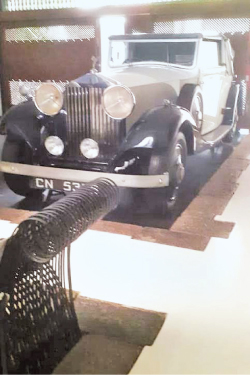 There is also an old Dutch period settee in the house. But this is not just any settee. Bawa was good at mixing pieces from Sri Lanka’s colonial past with more modern and contemporary pieces of his own designs. There is also a copy of a chair from South America and Goa.
There is also an old Dutch period settee in the house. But this is not just any settee. Bawa was good at mixing pieces from Sri Lanka’s colonial past with more modern and contemporary pieces of his own designs. There is also a copy of a chair from South America and Goa.
Light and ventilation play an important role in the house. The first courtyard also has a door that opens up into Geoffrey Bawa’s bedroom. And that further opens up into a secondary courtyard on the other side. Bawa’s bedroom was always naturally ventilated. It also gave Bawa a view of who was coming into the house and going out. So there was the security aspect of it as well.
The ladies pointed out that due to the import restrictions in the 60’s and 70’s Bawa lived during a time that required him to be innovative and creative with the limited but local resources. There were many interesting designs coming out of that period. There is a chair that is a copy of the Barcelona Chair, but Bawa localizes it by using a handloom fabric to upholster it by Barbara Sansoni. There is also a sample chair from the Bentota beach hotel, one of Asia’s first resorts in the late 60’s. One of Bawa’s favorite pieces is by Laki Senanayake, which is a sculpture called the “Sunken Cathedral”, made of lead and glass. Bawa liked it so much that it was on his work table when he was based at the gallery café, which was his former office.
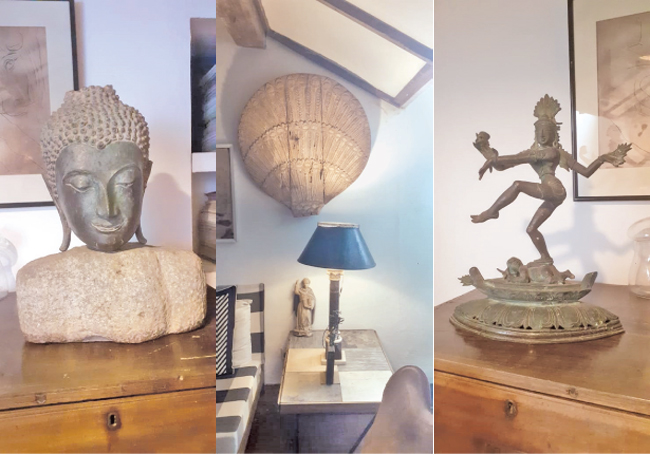
There are many such examples. There are so many pieces he has sourced from India or North of Sri Lanka, mixed up with all these modern pieces. In the house you will find that there are no hierarchies between religions or ethnicities, possibly because Bawa himself was from a mixed background, his father being Moor and his mother being Burgher. All through the house there are Christian statues alongside Hindu and Buddhist ones. So diversity is celebrated here.
It is a melting pot of cultures that highlights Bawa’s interest in travel. In the house there are also so many little glimpses of the projects he was a part of – e.g. a lamp that was done for a Kandalama hotel which you will see at Kandalama hotel.
At the house you will also see some drawings from Barbara Sansoni, and a chess set from Ena De Silva’s workshop (she also worked with wood and brass as well as the Batik and Embroidery). There are also features from the Embekka Dewalaya in Kandy in the dining room. They are in the proportions necessary for the space. So there is a mix of ancient and modern. Past and present. There is also a drawing by Laki Senanayake, titled “the Portuguese arriving in Ceylon”. This was actually the inspiration for the staircase done by Laki Senanayake for the Light House Hotel in Galle.
Visits and stays
Chief Curator Shayari De Silva, added that through visits and stays, they support the preservation and maintenance of these properties, the objects and public programmes that they do. “The trust also looks after these objects. There are over 1700 art works, over 4000 drawings, over 1260 archival documents and over 1000 books. All of these are there for the public and scholarly community to access, engage and research. The objects are very much connected to the spaces. As a result of managing all these properties, the trust has been at the forefront of conservation of modern art and architecture. We work with many different bodies,” said De Silva.
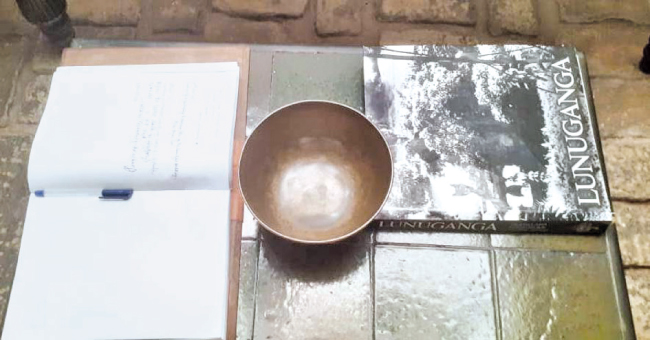
What the Trust is doing is nothing short of amazing. If you take the Ena De Silva house, it was relocated stone by stone in Bentota, because it was faced with demolition. That shows their commitment and passion. “You can now stay there. We have events there and an exhibition in July. As the Trust we are committed to ensure that we as a collective are not only looking at our antiquities and our archaeological heritage but also our modern architecture.”
This endeavor attempts to answer some of the biggest questions about our existence. What is the relevance of the past? How relevant is it to our present day? As Sri Lankans how do we try and understand all of this? “We need to build up a community that is interested in Bawa. The world must know about Bawa and his legacy and what he has done for this country.”
What De Silva say is true. In his homeland Bawa is famous and recognised, but not so much beyond the shores of Sri Lanka. Geoffrey Bawa was an inspiration to all aspiring architects. After all this is a person who built the parliament.
“We have done a ton of workshops and we had programmes every day. We are also very excited, because from this August to December we are going to the Yale University, architecture gallery in the University premises. It is an amazing way for us to talk about Sri Lanka. How do we portray ourselves to the rest of the world? We need to create new academic and cultural appetites for what we are doing,” pointed out De Silva.
GEOFFREY BAWA TRUST
The Geoffrey Bawa Trust was established in 1982. It has an amazing mandate of fostering Art, Architecture and Ecology. When Bawa passed away in 2003, the trust inherited his estate which comprised four properties including his Colombo House No. 11, his garden in Bentota, Lunuganga, the former architecture office which is now the gallery café and the Ena de Silva house which was moved from Colombo and now sits adjoining Lunuganga.
The Trust which
is a non-profit,
manages these four
properties. It is a gazetted charitable organisation that works in the culture sphere in the country. Funding for arts and culture is not easy in Sri Lanka, and the Trust does not receive government support.
The house is open every single day.
WHAT THE TRUST HAS BEEN DOING SINCE ITS INCEPTION
* Maintained Geoffrey Bawa’s historic residences at Lunuganga and No. 11, and their collections of fine and decorative arts.
* Made Lunuganga and No. 11 accessible to the public through daily guided tours and other avenues.
* Restored and reconstructed No. 5 at Lunuganga, the house designed by Geoffrey Bawa for Ena De Silva, by physically relocating the house from Colombo and reassembling it at its new location.
* Overseen the renovation of the Druvi De Saram house in Colombo 7 and undertaken its management and public programmes.
* Organised the triennial Geoffrey Bawa Awards, now in its 6th cycle, celebrating excellence in contemporary Sri Lankan Architecture.
* Hosted the annual Geoffrey Bawa Memorial lecture, now in its 21st cycle.
* Established a sanctuary for the endangered Hog Deer Species on Honduwa island, Lunuganga in partnership with the Department of Wildlife Conservation.
* Curated the Bawa 100 Centenary programme, a 2- year programme centered on Bawa’s legacy and collections comprising exhibitions, talks and tours.
Ishara Jayawardane




